
Charter chains have marketed themselves to disenfranchised populations such as black and poor families.
The school choice movement has its roots in mid-twentieth century, and was bolstered by some ugly truths about racism in the U.S. during the Civil Rights Movement and public school integration.
While school choice advocacy has maintained some foundational catch phrases such as “innovation” and relied on appeals to uncritical faith in market forces over “the damned government,” school choice has also maintained two key patterns: 1) promises associated with school choice advocacy have mostly failed, and thus, 2) “choice” has morphed repeatedly into new versions to stay ahead of all the bad news about outcomes falling short of those promises.
The last decade, however, has revealed a school choice gold mine in the charter school movement that appears to blend the public’s support for public schools with the allure of parental choice.
However, on balance, charter school advocacy has proven to be mostly rhetoric and absent evidence in ways similar to the larger school choice movement.
Public and charter schools, for example, are currently plagued with rising segregation, and both embrace policies that can fairly be labeled racist and classist ― leading the NAACP to maintain a strongly skeptical position about the credibility of charter schools.
And when charter schools appear to succeed where public schools do not, a careful analysis nearly always reveals that what is too good to be true is, in fact, not true.
School choice innovation, including charter school innovation, actually has little to do with education and more to do with keeping ahead of the evidence in order to maintain political and public support for finding yourself in a hole and continuing to dig.
For a glimpse into how the charter movement seeks mostly to keep itself afloat, often at the expense of children and their families, consider Paul Bowers’s late-July piece on the changing landscape of public education, written for the Post and Courier.
Bowers hits a key point in the following:
Across the U.S., the National Association of Charter School Authorizers has been sounding the alarm about a trend it calls “authorizer shopping,” which it calls “a growing threat to overall charter school quality.” “Authorizer shopping happens when a charter school chooses an initial authorizer or changes authorizers specifically to avoid accountability,” the group said in a 2016 report. “A low-performing school may shop for a new authorizer to avoid closure, or reopen under a new authorizer after closure.”
Also important to highlight is, as Bowers notes, how this new phase of charter expansion linked to less or no accountability is appealing to the least effective forms of charter schools:
Two of the first schools to express an interest in the new public charter school sponsor, the Charter Institute at Erskine College, are the S.C. Virtual Charter School and Cyber Academy of South Carolina. The two schools enrolled more than 4,000 students combined in kindergarten through 12th grade last school year.
The hard truths about educating children in a free society in order to create a more perfect union ― to reach and sustain an equitable democracy ― are that public education has mostly failed the children who need it most. The U.S. is plagued by political cowardice and schemes labeled “education reform” are mostly even worse alternatives (including school choice and charter schools) to the mismanaged public system.
Near the end of his life, Martin Luther King Jr. called for addressing poverty directly and, thus, eradicating related social inequities and empower public institutions:
In addition to the absence of coordination and sufficiency, the programs of the past all have another common failing ― they are indirect. Each seeks to solve poverty by first solving something else. I am now convinced that the simplest approach will prove to be the most effective — the solution to poverty is to abolish it directly by a now widely discussed measure: the guaranteed income. … We are likely to find that the problems of housing and education, instead of preceding the elimination of poverty, will themselves be affected if poverty is first abolished. The poor transformed into purchasers will do a great deal on their own to alter housing decay. Negroes, who have a double disability, will have a greater effect on discrimination when they have the additional weapon of cash to use in their struggle.

The radical MLK remains mostly unrecognized for mainstream Americans, but his legacy includes anti-war protests and calls for a guaranteed income.
King’s plea has been repeatedly justified since the claim that education is the great equalizer never materializes. For example, in “Equal Pay Day for African-American Women, By the Numbers,” Emily Crockett confronts:
African-American women only earn 64 cents to every dollar earned by non-Hispanic white men, according to the NWLC analysis; the figure for women overall is 77 cents. That’s based on the average earnings of female and male full-time, year-round workers taken from Census data. The pay gap for Black women varies based on age and industry. Older Black women have it the hardest—the pay gap is only 82 cents on the dollar for 15-year-old to 24-year-old Black women compared to white men, but the gap widens to 67 cents and 59 cents, respectively, for Black women ages 25-to-44 and 45-to-64. As for industries, Black women working as physicians and surgeons—a high-wage and male-dominated occupation—make only 52 cents for every dollar paid to their white male counterparts. Black women fared slightly better in lower-paid occupations, making 86 cents on the dollar in male-dominated, mid-wage construction industries and 85 cents on the dollar working as low-wage, mostly female personal care aides. … The fact that Black women are overrepresented in low-wage jobs doesn’t help, the analysis said. Black women make up 14 percent of low-wage workers and 6 percent of the overall workforce. Education levels don’t make much of an impact on the high wage gap between Black women and non-Hispanic white men. While more education corresponds with higher wages for both Black women and white men, Black women still make between 61 and 66 cents on the dollar compared to their counterparts at every education level [emphasis added]. African-American women have to have at least a Bachelor’s degree to make as much as white men who didn’t finish college.
This equity gap along race and gender lines is a lingering and powerful fact in the U.S.
Education reform, then, especially under the guise of school choice/charter schools, is once again failing to address directly the root causes of why we believe public education needs reform in the first place.
The only real innovation among the charter school advocates is how many ways they can avoid the hard truths about reforming schools and the impotence of education to overcome social inequity and injustice.